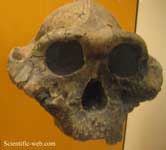Paranthropus boisei (originally called Zinjanthropus boisei and then Australopithecus boisei until recently) was an early hominin and described as the largest of the Paranthropus species. It lived from about 2.6 until about 1.2 million years ago during the Pliocene and Pleistocene epochs in Eastern Africa. First discovered by anthropologist Mary Leakey in July 1959 at Olduvai Gorge, Tanzania, the well-preserved cranium OH 5 (nicknamed "Nutcracker Man") was dated to 1.75 million years old and had characteristics distinctive of the robust australopithecines. Mary and her husband Louis Leakey classified the specimen as Zinjanthropus boisei: "Zinj" for the medieval East African region of Zanj, "anthropus" meaning ape or ape-human, and "boisei" for Charles Boise (the anthropologists team’s funder at the time). Paranthropus boisei (as the species was eventually categorized) proved to be a treasure especially when the anthropologists' son Richard Leakey considered it to be the first hominin species to use stone tools. Another skull was unearthed in 1969 by Richard at Koobi Fora near the Lake Turkana region. Morphology and interpretations The brain volume is quite small, about 500 and 550 cm³, not much larger in comparison to Australopithecus afarensis and Australopithecus africanus. It had a skull highly specialized for heavy chewing and several traits seen in modern day gorillas. P. boisei inhabited savannah woodland territories. Males weighed 68 kg (150 lb) and stood 1.3 m (4 ft 3 in) tall, while females weighed 45 kg (99 lb) and stood 1.05 m (3 ft 5 in) tall. The average adult males were much larger than females (sexual dimorphism), as was the case in virtually all australopithecine species. The back molar teeth were relatively large, with an area over twice as great as is found in modern humans.[1] The species is sometimes referred to as “Nutcracker Man” because it has the biggest, flattest cheek teeth and the thickest enamel of any known hominin.[2] Some argue that the craniodental morphology of this taxon (e.g., large postcanine dentition, thick enamel, robust mandibles, sagittal cresting, flaring zygomatic region) are indicative of a diet of hard or tough foods such ground tubers, nuts and seeds.[3] However, research on the molar microwear of P. boisei suggests that hard foods did not constitute a regular portion of its diet, but may have served as "fallback foods" when other fare was unavailable.[4][5] The carbon isotope ratios of P. boisei suggest that it had a diet dominated by C4 vegetation.
Paranthropus boisei reconstruction
Paranthropus boisei KNM ER 732, Paranthropus boisei KNM ER406 Fossils In 1993, A. Amzaye found fossils of P. boisei at Konso, Ethiopia. The partial skull's designation is KGA10-525 and is dated to 1.4 million years ago. It is the biggest skull specimen ever found of P. boisei. It has been claimed as the only remains of the species found in Ethiopia; all others have been in other parts of Eastern Africa. The oldest specimen of P. boisei was found in Omo, Ethiopia and dates to 2.3 million years old classified as (L. 74a-21) while the youngest speciemen from Olduvai Gorge dates 1.2 million years old classified as OH 3 and OH 38. Other well preserved specimens * OH 5 "Nutcrackerman" is the first P. boisei found by Mary Leakey at Olduvai Gorge, Tanzania belonging to an adult male (circa. 1.75 mya). * KNM ER 406 is a small partial cranium discovered by H. Mutua and Richard Leakey in 1969 found at Koobi Fora, Kenya displays large zygomatic arches, a cranial capacity of 510 cm³ (circa. 1.7 mya). * KNM WT 17400 a partial cranium with similar characteristics as KNM WT 17000 "Black skull" belonging to Paranthropus aethiopicus. The skull was found at West Turkana, Kenya (circa. 1.7 mya). * ER 406 was found by Richard Leakey and H. Mutua in 1970 at Koobi Fora, Kenya is a partial cranium most likely identified as belonging to a female (circa. 1.7 mya). See also * List of fossil sites (with link directory) References 1. ^ McHenry, H.M.; Coffing. K. (2000). "Australopithecus to Homo: transformations in body and mind". Annual Review of Anthropology 29: 125–146. doi:10.1146/annurev.anthro.29.1.125. http://www.anthro.ucdavis.edu/faculty/mchenry/Aust-Homo.pdf. External links
Retrieved from "http://en.wikipedia.org/" |
|




